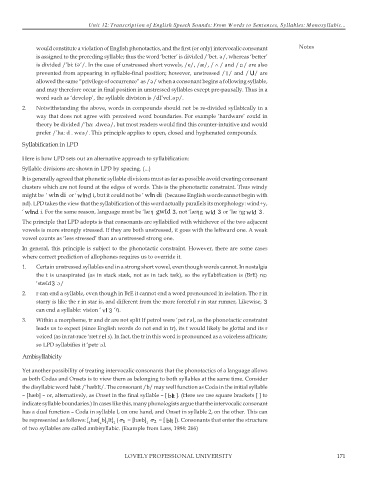Page 177 - DENG504_LINGUISTICS
P. 177
Unit 12: Transcription of English Speech Sounds: From Words to Sentences, Syllables: Monosyllabic...
would constitute a violation of English phonotactics, and the first (or only) intervocalic consonant Notes
is assigned to the preceding syllable; thus the word ‘better’ is divided /’bet. /, whereas ‘better’
is divided /’bi: t ’/. In the case of unstressed short vowels, /e/, /æ/, / ∧ / and / / are also
e
e
a
prevented from appearing in syllable-final position; however, unstressed / I / and / U/ are
allowed the same “privilege of occurrence” as / / when a consonant begins a following syllable,
and may therefore occur in final position in unstressed syllables except pre-pausally. Thus in a
e
word such as ‘develop’, the syllable division is /dI’vel. p/.
e
2. Notwithstanding the above, words in compounds should not be re-divided syllabically in a
way that does not agree with perceived word boundaries. For example ‘hardware’ could in
theory be divided /’ha: .dwe /, but most readers would find this counter-intuitive and would
e
prefer /’ha: d . we /. This principle applies to open, closed and hyphenated compounds.
e
Syllabification in LPD
Here is how LPD sets out an alternative approach to syllabification:
Syllable divisions are shown in LPD by spacing. (...)
It is generally agreed that phonetic syllable divisions must as far as possible avoid creating consonant
clusters which are not found at the edges of words. This is the phonotactic constraint. Thus windy
might be ‘ wn di or ' wnd i, but it could not be ‘ wn di (because English words cannot begin with
I
I
I
nd). LPD takes the view that the syllabification of this word actually parallels its morphology: wind+y,
‘ wnd i. For the same reason, language must be ‘læŋ gwdI 3, not ‘læŋg wd 3 or ‘læ ŋg wd 3.
I
I
I
The principle that LPD adopts is that consonants are syllabified with whichever of the two adjacent
vowels is more strongly stressed. If they are both unstressed, it goes with the leftward one. A weak
vowel counts as ‘less stressed’ than an unstressed strong one.
In general, this principle is subject to the phonotactic constraint. However, there are some cases
where correct prediction of allophones requires us to override it.
1. Certain unstressed syllables end in a strong short vowel, even though words cannot. In nostalgia
the t is unaspirated (as in stack stæk, not as in tack tæk), so the syllabification is (BrE) n a
‘stæld3 /
e
2. r can end a syllable, even though in BrE it cannot end a word pronounced in isolation. The r in
starry is like the r in star is, and different from the more forceful r in star runner, Likewise, 3
can end a syllable: vision ‘ Iv 3 ‘ŋ.
3. Within a morpheme, tr and dr are not split If petrol were ‘pet r l, as the phonotactic constraint
e
leads us to expect (since English words do not end in tr), its t would likely be glottal and its r
voiced (as in rat-race ‘ræt r Ie s). In fact, the tr in this word is pronounced as a voiceless affricate;
so LPD syllabifies it ‘petr l.
e
Ambisyllabicity
Yet another possibility of treating intervocalic consonants that the phonotactics of a language allows
as both Codas and Onsets is to view them as belonging to both syllables at the same time. Consider
the disyllabic word habit /’hæbIt/. The consonant /b/ may well function as Coda in the initial syllable
– [hæb] – or, alternatively, as Onset in the final syllable – [ Ibt ]. (Here we use square brackets [ ] to
indicate syllable boundaries.) In cases like this, many phonologists argue that the intervocalic consonant
has a dual function – Coda in syllable l, on one hand, and Onset in syllable 2, on the other. This can
be represented as follows: [ hæ[ b] It] (σ = [hæb] σ = [ Ibt ]). Consonants that enter the structure
1 z 1 2 1 1 2
of two syllables are called ambisyllabic. (Example from Lass, 1984: 266)
LOVELY PROFESSIONAL UNIVERSITY 171

